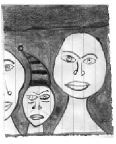ANTJUAN ODEN
Garde Rail Gallery 4860 Rainier S., 721-0107 opening reception: 6-10 p.m. Fri., Aug. 2
The Garde Rail Gallery in Columbia City specializes in self-taught and “outsider” artists, many of whom use junk metal and other rudimentary materials. But Garde Rail’s newest exhibition, opening Friday night, will showcase an artist who had nothing more at his disposal than instant coffee, toilet tissue, and scrap paper: Antjuan Oden recently completed a 13-month prison term, including several weeks of solitary confinement, during which he secretly created his tiny, 2-inch-by-3-inch “coffee paintings.”
“We were blown away by them,” says Garde Rail co-owner Marcus Pi�who has represented Oden since 1998 but was surprised when the prison-made paintings showed up in his mailbox. “There’s all kinds of shading, dots, fine and thick lines. You’ll wonder how he did it.”
Some of the pieces are dark and despairing, with flames, bars, a crowned skull, a hooded head emblazoned with Oden’s prisoner number (818411). Others are absurd and funny, portraying sad-eyed animal creatures. In addition to 75 coffee paintings, the exhibition, titled “The Myth of Captivity and the Truth of Consequence,” will include larger acrylic paintings done when Oden had access to the prison hobby shop, plus work he’s created since his release in March.
Oden was convicted of assault after stabbing another man in the shoulder in March 2000 outside the OK Hotel, where Oden worked as a bouncer. The circumstances surrounding the incident were murky: There were drunk patrons, a loud dispute, confusion under the viaduct. Oden admitted to the stabbing—in fact, he told club owners to call the police—but he said he had acted in self-defense after several of the patrons had ganged up on him. He refused to plead guilty and, with a public defender representing him, went to trial.
Court documents indicate that none of the witnesses supported Oden’s version of events. A psychiatrist who had been treating Oden for bipolar disorder and depression in early 2000 testified that the artist was likely experiencing mild-to-moderate paranoia around the date of the incident. The jury—all white, according to Oden, as were the other people involved in the OK scuffle—deadlocked on first-degree assault (which requires intent to cause great bodily harm) but found Oden guilty of assault in the second degree. The victim of the stabbing—who had an artery and two nerves severed—has not regained full use of his arm.
Though Oden’s art helped sustain him in prison, it was, disturbingly, also used by the prosecution to help send him there. During cross-examination, King County prosecutor Gary Ernsdorff began inquiring about certain artwork that Oden had exhibited at the OK. The pieces, which explored the theme of “penetration,” consisted of three female mannequins with knives and arrows stuck into them.
“Do you remember some pieces so graphically violent you were asked to remove them?” Ernsdorff asked. Oden’s attorney objected but was overruled by the judge. “Do you remember Steve [Freeborn, the owner of the OK Hotel] asking you to take down mannequins that had knives stuck in their torsos because they were offensive?” Ernsdorff asked again. Later, the prosecutor made a third reference to “the knives sticking in the mannequins.”
Jurors were never shown the artworks, and they were never entered into evidence. But Oden’s attorney argues this was a “patently obvious” effort “to imply that a person who stuck a knife into a mannequin would do the same to a person”—which violates the rules of evidence as well as Oden’s First Amendment rights.
The King County prosecutor’s office has since admitted that its attempt to impugn Oden through his artwork was improper and that the trial judge “erred” in allowing such a line of questioning. But the prosecution contends this mistake is not sufficient to throw out Oden’s conviction.
A decision from an appellate judge is expected any day. Prosecutor Ernsdorff says that if Oden wins the appeal, he will try him again on the first-degree assault charge.
Re-entering the Seattle art world, where he had been active for several years, Oden, who is 31 and had no criminal record, says his imprisonment “made me appreciate being creative so much more.” It took him a long time to feel he could call himself an artist; now, he says, “I want to be worthy of it.”









